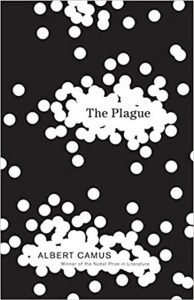Timeliness of Albert Camus’ Book, ‘The Plague’
We live in dangerous times. The number of people who have been infected and died from the Coronavirus Pandemic proves it. Our America is running at half-speed at the moment.
As of today, over 80,000 deaths, and 1.3 million infections have been reported by the authorities. The comments about the lethal virus have run from the absurd to the profound. Meanwhile, we’re just hearing about yet another plague: People in Hong Kong are becoming ill with “rat hepatitis” for the first time ever.
(And few will ever forget how President Donald Trump, on April 23rd, at a press conference, suggested that disinfectants and light might have the potential to treat the coronavirus.)
It all reminds me of Albert Camus’ best-selling, and currently very timely book, “The Plague.” I recall it as required reading in Professor Daniel Craig’s Literature class at the U. of Baltimore many moons ago.
 “The Plague” was a fable about the coastal city of Oran, in North Africa. It was set in the 1940s. Camus, born to French parents, in Algeria, then a French colony, labeled Oran as “an ordinary city.” He started on the book in the early 40s but became ill. It wasn’t published until 1947, two years after the end of World War II.
“The Plague” was a fable about the coastal city of Oran, in North Africa. It was set in the 1940s. Camus, born to French parents, in Algeria, then a French colony, labeled Oran as “an ordinary city.” He started on the book in the early 40s but became ill. It wasn’t published until 1947, two years after the end of World War II.
Camus got sidestepped in finishing the book by the war itself. He participated in the “Resistance Movement” in Paris against the occupying Nazi forces.
While his contemporary Jean-Paul Sartre was supposedly sitting on the sideline during that conflict, Camus became widely known as a result of serving as the editor of the Resistance’s popular journal, “Combat.” He couldn’t help giving Sartre a jibe about it. According to author Paul Johnson, it went like this: “Sartre tried to make history from his armchair.” Ouch!
Pundit Tony Judt, said that Camus emerged as an intellectual leader for many of his contemporaries during this trying period. The readers of his editorials had “formed a habit of getting their daily thought from him.”
The plot of “The Plague” goes like this: Rats become infected and then fleas spread the disease to other animals and eventually to humans. The residents of Oran are trapped- quarantined. They are slowly dying off, more and more of them every day. They can’t get out and no one else is allowed in. The plague continues to run rampant, bringing death and widespread misery. A feeling of isolation and hopelessly engulfs the psyches of the peoples of Oran.
Camus paints Oran as a city where the people lived “busy money-centered and denatured lives,” according to the writer, Alan De Botton. Then, suddenly, the horror begins.
This desperate situation permits Camus to make a key point in his philosophy: Humanity is always vulnerable to extermination and at any time! De Botton adds: The culprit “could be a virus, an accident or the actions of our fellow man.”
De Bottom continues: “For Camus when it comes to dying there is no progress in history, there is no escape from our fragility. Being alive always was and will always remain an emergency. It is truly an inescapable underlying condition.”
Camus has a character say: “It’s impossible it should be the plague, everybody knows it has vanished from the West.” The narrator adds, “Yes, everybody knew that, except the dead.”
Was “The Plague” a simple allegory of France’s wartime drama? Reviewers disagree. De Bottom says “no,” and Judt comes in with a “yes.” I come down on the side of Judt.
France after WWII was a bitterly divided country. If you had openly supported the Nazis, you could face a firing squad. There was a lot of enthusiasm for “violent revenge,” Judt wrote. To some, Camus’ allegory wasn’t vicious enough to suit their temperaments. They wanted blood splattered on the collaborators.
Moralizing runs throughout Camus’ book. There are seven major characters in “The Plague.” The author gives each of them enough of a role, along with a narrator, to enable him to carve out his philosophical and moral points with their actions.
Camus’ writings are mostly connected to the concept of “Absurdism,” which some prefer to label “Existentialism.” The author rejected the latter label. Judt felt that Camus had seen “evil” as the fundamental question of postwar intellectual life in Europe.
The reader will draw his or her own conclusions from “The Plague.” This is the way Camus would have wanted it.
Some may even see “The Plague” as a metaphor today for the grasping, unchecked “Capitalism” currently running amok in the country, sucking the blood out of the workers and leaving a wasteland in its place. They will point to the precipitous decline of union membership from about 20.1 percent of the workforce in 1983 (17.7 million members), to about 10.3 percent today (14.4 million members), as their “Exhibit A.”

Camus would be proud of any reader who questions the status quo, regardless of their viewpoint. The author later became known for protesting against any kind of oppression or injustice that demeans the human condition. If he were alive today, he would be a very busy commentator with a boxcar load of powerful, and often deadly, enemies looking to take him on. Camus won a Nobel Prize for his literary work in 1957.
Camus died in 1960, at the age of 46, in a car accident. He was headed to Paris. The author had a “train ticket” in his pocket, but had decided not to use it. Camus also wasn’t wearing his seat safety belt. The car hit a tree. He died instantly.
Let me suggest: Now, is a perfect time, if you haven’t read it, to introduce yourself to Albert Camus’ most-honored literary effort, “The Plague.” Our America is in the midst of a killer Coronavirus Pandemic. So, you are as close as you can be to a perfect frame of mind to imagine yourself a desperate, frightened citizen of Oran, Algeria, in the 1940s. Beware!

Bill Hughes is an attorney, author, actor and photographer. His latest book is “Byline Baltimore.” It can be found at: https://www.amazon.com/William-Hughes/e/B00N7MGPXO/ref=dp_byline_cont_book_1

